

The Internet of Things. Notebook2_theinternetofthings.pdf. August 2012. This is the second post in a series documenting my investigation into data models for pervasive interoperability on the Internet of Things.
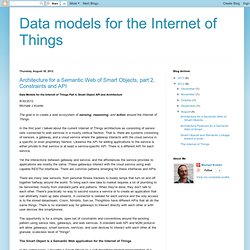
Here I'm looking into the information architecture inside the data model. Previously, I mentioned that many sensors and devices already have the ability to connect to the internet. There is emerging a common way for devices and sensors to present themselves on the internet, which is through a RESTful interface. In short, Representational State Transfer is a style of communication that allows interfaces to be stateless and self-describing. Using REST allows two entities to exchange information is a well defined way without them having to know in advance what the other endpoint is going to do internally. Newsroom_UK_InternetOfThings_1024x1448.jpg (Image JPEG, 1024x1448 pixels) - Redimensionnée (55%) How you and I could become nodes in the internet of things.
Ever wonder what the network infrastructure of the future will be?
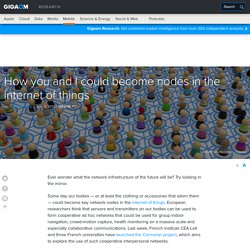
Try looking in the mirror. Some day our bodies — or at least the clothing or accessories that adorn them — could become key network nodes in the internet of things. European researchers think that sensors and transmitters on our bodies can be used to form cooperative ad hoc networks that could be used for group indoor navigation, crowd-motion capture, health monitoring on a massive scale and especially collaborative communications. A LIVING NETWORK OF ‘META PRODUCTS’
Imagine a world where everything from products to people, spaces and services is connected and together operates as a living network.
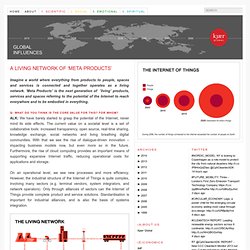
‘Meta Products’ is the next generation of ’living’ products, services and spaces referring to the potential of the Internet to reach everywhere and to be embodied in everything. Q: What do you think is the core value for this? For whom? Microsoft Word - IJWEST 01 - 3112ijwest01.pdf. Web 1.0 vs Web 2.0 vs Web 3.0 vs Web 4.0 – A bird’s eye on the evolution and definition. Please check my new page (Digital Evolution) on how web (technology) is evolving!!
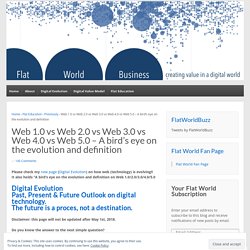
It also holds “A bird’s eye on the evolution and definition on Web 1.0/2.0/3.0/4.0/5.0 Digital EvolutionPast, Present & Future Outlook on digital technology.The future is a proces, not a destination. Disclaimer: this page will not be updated after May 1st, 2018. Do you know the answer to the next simple question? “What do you know about web 2.0 technology?” Are the Internet of Things (IoT) & Internet of Everything (IoE) the Same Thing?
Introduction: For quite some time, Cisco and Qualcomm have used the term Internet of Everything (IoE) to describe what almost everyone else refers to as the Internet of Things (IoT).
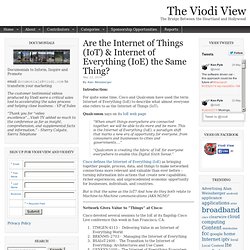
Qualcomm says on its IoE web page “When smart things everywhere are connected together, we will be able to do more and be more. Energie de récupération et objets connectés au menu du salon Hot Chips. De nouvelles technologies de récupération énergétique basées sur l’énergie corporelle ou l’énergie ambiante ont été évoquées les 10 et 11 août derniers lors de la conférence Hot Chips 2014 qui se tenait à Cupertino aux Etats-Unis.

Des technologies qui pourraient bien alimenter des appareils électroniques portables de faibles puissances et remplacer ainsi des batteries à la fois trop encombrantes et trop limitées. Récupération et optimisation de l’énergie corporelle et ambiante. Web 4.0 and beyond? L’ère du Web Proactif : le Web Intelligent et les services intelligents sonnent à nos portes ! Tout juste âgé de 22 ans (Naissance du Web par Tim Berneers Lee en 89), le Web ou World Wide Web est occupé de vivre une nouvelle étape majeure de son cycle de vie, cette étape qui sera très certainement marquée par l’arrivée de nouveaux usages, nouvelles attentes et nouveaux besoins qui seront rapidement manifestés par ses utilisateurs.
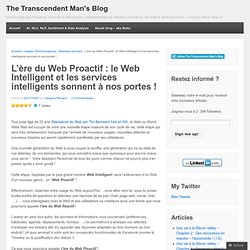
Une nouvelle génération du Web à vous couper le souffle, une génération qui ira au-delà de vos attentes, de vos demandes, qui vous connaitra mieux que quiconque pour encore mieux vous servir ! 4-Veille. The RoboEarth Cloud Engine. Can Machines Communicate? - The Internet of Things and Interoperability of Information. Freeboard - Dashboards For the Internet Of Things. Dweet.io - Share your thing- like it ain't no thang. A Common Language for the Internet of Everything - AllJoyn. The Plan to Build a Massive Online Brain for All the World’s Robots.
Getty If you walk into the computer science building at Stanford University, Mobi is standing in the lobby, encased in glass.
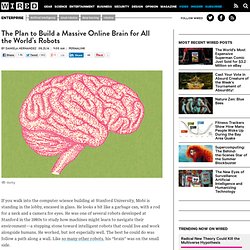
He looks a bit like a garbage can, with a rod for a neck and a camera for eyes. He was one of several robots developed at Stanford in the 1980s to study how machines might learn to navigate their environment—a stepping stone toward intelligent robots that could live and work alongside humans. He worked, but not especially well. The best he could do was follow a path along a wall. Now, just down the hall from Mobi, scientists led by roboticist Ashutosh Saxena are taking this mission several steps further. Today, backed by funding from the National Science Foundation, the Office of Naval Research, Google, Microsoft, and Qualcomm, Saxena and his team unveiled what they call RoboBrain, a kind of online service packed with information and artificial intelligence software that any robot could tap into. Skynet: Internet of Things vs. Industrial Internet. My friend Jeff Frick (@JeffFrick of SiliconANGLE) was educating me recently on the difference between the Internet of Things (IoT) and the Industrial Internet.
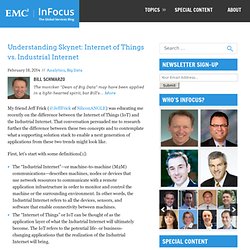
That conversation persuaded me to research further the difference between these two concepts and to contemplate what a supporting solution stack to enable a next generation of applications from these two trends might look like. First, let’s start with some definitions[1]: The “Industrial Internet”—or machine-to-machine (M2M) communications—describes machines, nodes or devices that use network resources to communicate with a remote application infrastructure in order to monitor and control the machine or the surrounding environment. In other words, the Industrial Internet refers to all the devices, sensors, and software that enable connectivity between machines.The “Internet of Things” or IoT can be thought of as the application layer of what the Industrial Internet will ultimately become.
Prepping the cloud for the internet of things. Estimates vary about the number of connected devices there will be as the internet of things shapes up – a recent Gartner estimate was 26 billion by 2020 — but everyone agrees there will be a ton.
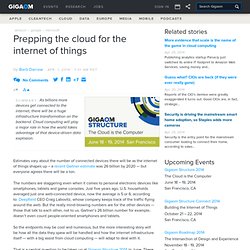
The numbers are staggering even when it comes to personal electronic devices like smartphones, tablets and game consoles. Just five years ago, U.S. households averaged just one web-connected device, now the average is 5 or 6, according to Deepfield CEO Craig Labovitz, whose company keeps track of the traffic flying around the web. But the really mind-blowing numbers are for the other devices — those that talk to each other, not to us. Shodan. 7 Big Problems with the Internet of Things. Reality is beginning to bite the Internet of Things (IoT). After months of enthusiastic discussion about the opportunities it will provide and how much it will be worth, many of those looking to play in the IoT space are starting to look at the potential problems, including data management.
Though everyone knows managing data will be a problem once the IoT is up and running at full scale, few have really considered the potential data storage problems. The Problem With Data Sure there have been hypothetical discussions around compliance, privacy or the kind of information that consumers will be happy to offer to businesses in exchange for better customer experiences. But there has been little discussion around the subject of where exactly enterprises plan to store the massive amounts of data that will be created. Think about it. Where is all the data provided by those processors going to be stored and what are the problems around them? Twitter-like Consumer App Arrives for the Internet of Things. The vision driving the Internet of Things is one of a world where the car tells you it needs a new belt, the iron notifies you it’s been on for a while and allows you to turn it off remotely.
A cow might also let a farmer know that she’s in heat and should be artificially inseminated ASAP. In other words, the Internet of Things empowers things to tell users how best to use them, whatever that means in a particular industry. While that connected world continues to grow, its adoption is progressing much more slowly than that of, say, smartphones.
The trouble may go back to Steve Jobs’s famous talking point: The Internet of Things lacks a common platform that “just works” the way the iPhone did. The internet of things will require new thinking on data centers. ConnectedObject. Web 4.0: The Ultra-Intelligent Electronic Agent is Coming. Without getting too far ahead of ourselves, it is useful to look back at the various iterations of the Internet to see how it has evolved and where we might reasonably expect to see it go in the coming years and decades. The defining aspect of Web 1.0 was search. In other words, think Yahoo! In the early 1990s. Web 2.0 is social media, which involves collaborative projects like Wikipedia, social networking sites like Facebook, blogs and micro-blogs like Twitter and many other examples.
Making Sense Of The Internet Of Things. Editor’s note: Matt Turck is a managing director of FirstMark Capital. Follow him on Twitter @mattturck. The emerging Internet of Things — essentially, the world of physical devices connected to the network/Internet, from your Fitbit or Nest to industrial machines — is experiencing a burst of activity and creativity that is getting entrepreneurs, VCs and the press equally excited. Feel, Act, Make sense. Objets connectés et internet des objets. Objets connectés et domotique. Connected Objects : L'actualité des objets connectés en français. SAP: 'Internet of Things' is Future of Information Management, Smart Cities [Infographic]
If you've ever wondered where information management and related IT fields are going, or where all the different strands will come together, new research by SAP may have the answer — Machine to Machine (M2M) technologies across a vastly expanded internet are the next step in information and data management. The Internet of Things To do this, the Web will become much more than the Web we are familiar with today, becoming what SAP describes as the 'Internet of Things'. This is a concept that envisages a world where machines, people, enterprise resource planning (ERP) and customer relationship management (CRM) are all tied up with other information sources like social media, and the capabilities to analyze and use that data where it is needed.
For Sanjay Poonen, Head of Mobile Division at SAP, the entire concept can be summarized as follows: … M2M technology is primarily being used to collect vast amounts of machine and people-based data. SAP, Smart Cities M2M Enterprises. Connecting the Internet of Things. We are pleased to inform our readers that the Real-Time Cloud blog is now a part of Skkynet Cloud Systems, Inc. You can find the content for this blog here. Skkynet Cloud Systems, Inc. is a business that has evolved out of Cogent Real-Time Systems Inc., an established industrial middleware vendor that has introduced a number of innovations to their real-time data product including a high-speed redundancy facility and a web-based user interface providing immersive, desktop-quality graphics.
Cogent has developed new, patent-pending technology that solves the data transmission problems of data rate, latency, redundancy and security in cloud-based systems with a unique “push + pull” solution that insulates both a facility and a remote user from opening their firewalls to the Internet. This solution can act as a simple add-on to existing SCADA (Supervisory Control and Data Acquisition) systems, or as the basis for a new deployment.
Ubiquitous computing. Ubiquitous computing (ubicomp) is a concept in software engineering and computer science where computing is made to appear everywhere and anywhere. In contrast to desktop computing, ubiquitous computing can occur using any device, in any location, and in any format. A user interacts with the computer, which can exist in many different forms, including laptop computers, tablets and terminals in everyday objects such as a fridge or a pair of glasses. The underlying technologies to support ubiquitous computing include Internet, advanced middleware, operating system, mobile code, sensors, microprocessors, new I/O and user interfaces, networks, mobile protocols, location and positioning and new materials.
This new paradigm is also described as pervasive computing, ambient intelligence,[1] ambient media[2] or 'everyware'.[3] Each term emphasizes slightly different aspects. Tiny Computers That Collect Data from Anywhere. If the Internet is to reach everywhere—from the pills you swallow to the shoes on your feet—then computers will need to get a whole lot smaller.
Art and the Internet of Things. Wireless is increasingly pulling in all kinds of applications, platforms, services and things (rfid) into networks. Many people communicate through mobiles, blackberries, digital organizers, palmtops. Cars become information spaces with navigational systems and consoles like Nintendo DS have wireless capacities and get linux kernels installed.We are witnessing a move towards pervasive computing and disappearing technologies in intelligent clothing (wearables), smart environments (knowing where and who we are), pervasive games, and we will see doors opening for some and closing to others. Are you ready for the Internet of Things? Les Objets Connectés. Radio-frequency identification. NFC Magazine - NFC Technology Information & News - NFCMagazine.com.
Near field communication. A summary of near-field communication. Des QRCodes littéraires dans le métro. A Bucarest, les couloirs de la station de métro de la place Victoria (Piata Victoriei) sont constellés de livres. Oh, certes, pas de vrais livres, physiques, en papier, mais plutôt un gigantesque revêtement couvrant murs et plafond et figurant des ouvrages. Internet of Things. The Internet of Things (IoT) is the network of physical objects or "things" embedded with electronics, software, sensors and connectivity to enable it to achieve greater value and service by exchanging data with the manufacturer, operator and/or other connected devices. Untitled. This article was taken from the July 2013 issue of Wired magazine. Be the first to read Wired's articles in print before they're posted online, and get your hands on loads of additional content by subscribing online. To talk of the new coolness, we must first address that which is not cool -- and the fridge, metaphorically at least, is never cool.
The Internet of Things. Click here for more information on IBM's Smarter Cities initiatives Video featuring, from IBM: Mike Wing, Andy Stanford-Clark and John Tolva. Over the past century but accelerating over the past couple of decades, we have seen the emergence of a kind of global data field. The planet itself - natural systems, human systems, physical objects - have always generated an enormous amount of data, but we weren't able to hear it, to see it, to capture it. Futurist's Cheat Sheet: Internet of Things.
Plug comp Sensors. Top 50 Internet of Things Applications - Ranking. How-The-Internet-Of-Things-Will-Create-A-Smart-World-Infographic.png (Image PNG, 5031x3579 pixels) - Redimensionnée (21%) Tracking the Internet of Things. IoTA: Internet-of-Things Academy, Phase 1. Internet of things infographic. Says the Internet of Things Installed Base Will Grow to 26 Billion Units By 2020. Internet of Things, when everything is connected [The Conference] From Smart House to Networked Home. What's Holding Up The Internet Of Things. How The Internet Of Things Will Think. Did You Know 4.0. Joel de Rosnay : les quatre web. Le web 4.0, le futur proche ! Des milliards d'objets connectés.
From Web1.0 to web4.0. Web4. Futur du Web 4.0 Le fusionnement cognitif.